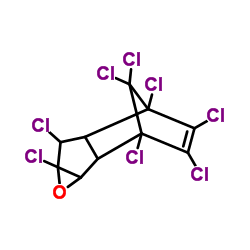OXYCHLORDANE

OXYCHLORDANE structure
|
Common Name | OXYCHLORDANE | ||
|---|---|---|---|---|
| CAS Number | 27304-13-8 | Molecular Weight | 423.762 | |
| Density | 2.0±0.1 g/cm3 | Boiling Point | 442.3±45.0 °C at 760 mmHg | |
| Molecular Formula | C10H4Cl8O | Melting Point | 144°C | |
| MSDS | N/A | Flash Point | 165.1±28.8 °C | |
| Symbol |

GHS07 |
Signal Word | Warning | |
|
Selective bioaccumulation of chlorinated pesticides and metabolites in Arctic seabirds.
Environ. Pollut. 145(2) , 545-53, (2007) Chlorinated pesticides and metabolites (CPs) were quantified in the seabird species: little auk (Alle alle), Brünnich's guillemot (Uria lomvia), black guillemot (Cepphus grylle) and black-legged kittiwake (Rissa tridactyla). The purpose was to evaluate avian ... |
|
|
Age at natural menopause and exposure to organochlorine pesticides in Hispanic women.
J. Toxicol. Environ. Health A 67(18) , 1407-22, (2004) A cross-sectional study was conducted to evaluate the relationship between exposure to selected organochlorine pesticides (OCP) (p,p'-DDT, p',p'-DDE, dieldrin, hexachlorobenzene, beta-hexachlorocyclohexane [beta-HCH], oxychlordane, trans' nonachlor) and age a... |
|
|
Enantioselective and gender-dependent depletion of chlordane compounds from rat tissues.
J. Toxicol. Environ. Health A 68(22) , 1917-38, (2005) Isomers and metabolites of the organochlorine pesticide chlordane persist in the environment and bioaccumulate in Arctic marine food webs. Rodent studies indicate that there are gender-related differences in trans-nonachlor and oxychlordane metabolism. Thus, ... |
|
|
Three decades (1983-2010) of contaminant trends in East Greenland polar bears (Ursus maritimus). Part 1: legacy organochlorine contaminants.
Environ. Int. 59 , 485-93, (2013) Legacy organochlorine contaminants were determined in adipose tissues from 294 polar bears (Ursus maritimus) sampled in East Greenland in 23 of the 28years between 1983 and 2010. Of 19 major legacy contaminants and congeners (ΣPCB, 4 PCB congeners (CB153, 180... |
|
|
Low dose of some persistent organic pollutants predicts type 2 diabetes: a nested case-control study.
Environ. Health Perspect. 118(9) , 1235-42, (2010) Low doses of some persistent organic pollutants (POPs) associate cross-sectionally with type 2 diabetes, whereas associations with high POP exposures are inconsistent.We investigated whether several POPs prospectively predict type 2 diabetes within the Corona... |
|
|
A strong dose-response relation between serum concentrations of persistent organic pollutants and diabetes: results from the National Health and Examination Survey 1999-2002.
Diabetes Care 29(7) , 1638-44, (2006) Low-level exposure to some persistent organic pollutants (POPs) has recently become a focus because of their possible link with the risk of diabetes.Cross-sectional associations of the serum concentrations of POPs with diabetes prevalence were investigated in... |
|
|
Maternal pregnancy levels of trans-nonachlor and oxychlordane and prevalence of cryptorchidism and hypospadias in boys.
Environ. Health Perspect. 120(3) , 478-82, (2012) The etiologies of the male urogenital anomalies--cryptorchidism and hypospadias--are poorly understood. Given positive associations between chlordane isomers and testicular germ cell tumors, it is reasonable to assume that chlordanes might also be associated ... |
|
|
Toxicokinetics of dioxins and other organochlorine compounds in Japanese people: association with hepatic CYP1A2 expression levels.
Environ. Int. 53 , 53-61, (2013) Concentrations of persistent organochlorine compounds (OCs) including polychlorinated dibenzo-p-dioxins (PCDDs), polychlorinated dibenzofurans (PCDFs), and polychlorinated biphenyls (PCBs) in the liver and adipose tissue of Japanese cadavers were measured, an... |
|
|
The link between the insecticide heptachlor epoxide, estradiol, and breast cancer.
Breast Cancer Res. Treat. 90(1) , 55-64, (2005) Given the suspected effects of estrogens on breast cancer, xenoestrogenic insecticides may be a risk factor. Studies of the weak xenoestrogen, 1,1-dichloro-2,2-bis(p-chlorophenyl)ethylene (DDE), have failed to demonstrate a causal relationship, though another... |
|
|
Xenoestrogens: do they lower survival after thermal injury?
Arch. Environ. Health 58(9) , 597-604, (2003) The effect of hormone disruptors on human health is an area of recent concern. The authors measured heptachlor epoxide and oxychlordane--the body storage forms of estrogenic insecticides-in the sera of patients with major burns (i.e., 7 survivors and 10 age- ... |